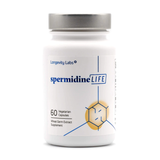
What does senolytic mean? Senolytics improve the physical function of your cells and increase your lifespan. Senescent cells accumulate in tissues as we get older and at places in the body where chronic illnesses are present. Senolytics are used to combat these harmful senescent cells and improve our health.
What Are Senolytic Cells?
How do senolytics work? A senolytic is a class of small molecules that researchers believe can induce the cellular death of senescent cells. While causing cellular death sounds like a bad thing, senescent cells are harmful to human beings. Ridding your body of these senescent cells before they can do too much damage to our cellular wellbeing can help improve our overall health and increase longevity.
It is important to note that research and senolytic human trials are still in their infancy. Animal studies targeting senescent cells have been done using genetic or pharmacological approaches. These were proven to delay, prevent, and alleviate multiple age-related issues, chronic diseases, geriatric illnesses, and loss of physiological resilience. Chronic conditions successfully treated by the removal of senescent cells in preclinical studies include:
- Frailty
- Cardiac dysfunction
- Vascular hyporeactivity and calcification
- Diabetes
- Liver steatosis
- Osteoporosis
- Vertebral disk degeneration
- Pulmonary fibrosis
- Radiation-induced damage
If senolytics prove to be effective and safe in human clinical trials, they could transform geriatric medicine tremendously. This would allow the prevention and treatment of multiple diseases and functional deficits simultaneously, instead of one at a time.
What Is Senolytic Therapy?
Healthy aging is restricted because natural selection favors genetic programs that confer fitness early in life to maximize reproductive output without considering how these changes may have adverse effects later in life. Cellular senescence enhances reproductive success by blocking the generation of cancerous cells but decreases the health of the elderly by littering tissues and organs with senescent cells.
Part of what makes senescent cells so dangerous is that they avoid and resist cellular death. They achieve this by activating prosurvival and inhibiting pro-apoptotic pathways. To be successful, senolytic drugs and senolytic therapies aim to target the critical components of these pathways, eliminating the senescent cells, senolytic therapies is a way to combat this.
What Is Senolytic Treatment?
What is senolytic therapy? Senolytic drugs are agents that selectively cause the death of senescent cells. These cells accumulate in many tissues as we age and at sites of disease in multiple chronic illnesses. The best senolytic supplements may contain quercetin or fisetin. These are shown to decrease senescent cells and increase longevity.
What Do Senolytic Drugs Do?
Cellular senescence is a contributing factor in aging and diseases that are common among older people. Senolytic drugs that selectively kill senescent cells may delay the aging process. Senolytic drugs may also increase longevity and youthfulness.
Is Quercetin a Senolytic?
Quercetin is a naturally occurring plant flavonol used commonly as a dietary supplement. Researchers have found that nanoparticles coated with quercetin molecules can selectively target and eliminate harmful senescent cells. In past studies conducted on mice and in recent human trials, quercetin used with the cancer drug ‘dasatinib’ can be the basis for an effective therapy for eliminating senescent cells. Unfortunately, quercetin does not appear to have a significant senolytic effect when used on its own.
These studies are a positive demonstration of how naturally occurring molecules such as quercetin can be enhanced to be more effective. Fisetin and other similar polyphenols have the potential for this approach and could open the door to new and less expensive senolytic therapies. Further studies hope to shed light on whether quercetin can be used in cancer prevention.
What Are the Side Effects of Quercetin?
Quercetin is used to treat many different ailments and is especially effective in combination with zinc. Quercetin is a treatment option for the following:
- seasonal allergies
- prevention of diabetic cataracts
- viral infections
- cardiovascular disease
- chronic prostatitis
- interstitial cystitis.
Quercetin is also used as adjunctive therapy in cancer treatment. It can be used both orally or intravenously. As with all medications, there are possible side effects when using quercetin.
Common side effects of quercetin may include:
- Headache
- Numbness and tingling
- Shortness of breath
- Nausea and vomiting
- Kidney damage
Is Fisetin a Senolytic?
A study conducted by the Mayo Clinic found that fisetin is a senotherapeutic that extends health and lifespan. In the study, researchers tested ten flavonoids, and fisetin was the most potent senolytic. Fisetin reduced senescence markers in multiple tissues, reduced senescence in a subset of cells in mice and human tissue, demonstrating cell-type specificity. In mice, it also reduced age-related pathology and extended average and maximum lifespan.
Are Fisetin Supplements Safe?
Fisetin supplements are generally considered safe for oral consumption. Fisetin is a natural product found in many fruits, vegetables, and nuts. It has no reported adverse side effects, but you should follow the dosing instructions to avoid fisetin toxicity as with any supplement. Consultation with your doctor is also advised before taking any supplements.
How Do You Eliminate Senescent Cells?
Researchers have recently discovered how immune cells naturally rid the body of senescent cells. Invariant Natural Killer T (iNKT) cells are immune cells that eliminate senescent cells. These iNKT cells become less active as we age. Scientists have now discovered they could use lipid antigens to activate iNKT cells and remove senescent cells. These findings in mice may lead to new ways to treat age-related chronic diseases with immunotherapy.
Can Senescence Be Reversed?
Studies are still being conducted to determine the process of senescent cell removal. One study suggests that the senescence arrest caused by telomere dysfunction is reversible. In some human cells, senescence may be irreversible.
Spermidine and Cellular Health
Aging is a natural part of our lives. But how we age and at what speed can be influenced by our lifestyle choices and diet. On the topic of cellular health, spermidine, a naturally occurring polyamine, has been identified as a potent proponent for cellular health. Spermidine aids in cellular health by regulating cellular metabolism through the process of autophagy. Spermidine has been shown to reduce inflammation and promotes brain, immune and cardiovascular health.
A natural process of aging is the degradation of cells. Built up cellular toxins and dysfunctional organelles can lead to serious illnesses and disease. Spermidine removes cellular debris, preventing aged and damaged cells from multiplying and causing damage within our bodies. As these damaged cells are cleared of cellular debris they can function properly without impairment.







